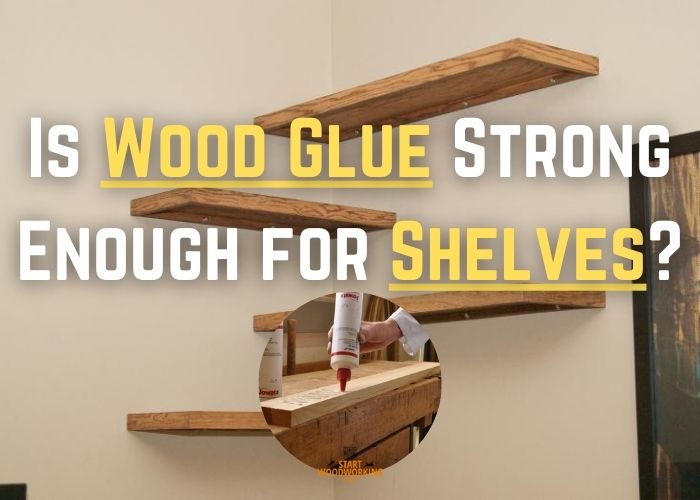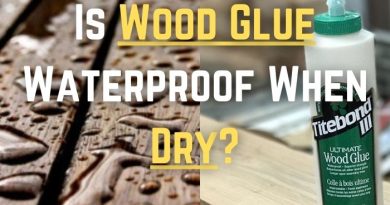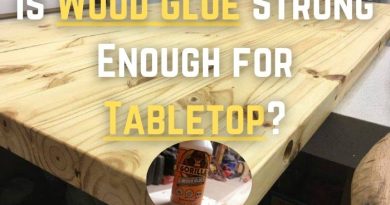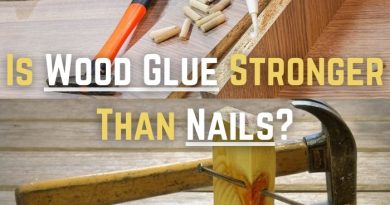Is Wood Glue Strong Enough for Shelves? Common Myths Debunked!
If you’re planning to build shelves, you may be wondering if wood glue is strong enough to hold them together. We’ll be taking a look at some different glues and their strength ratings, as well as the right way to apply ‘em.
As a woodworking expert, I can confidently state that wood glue is indeed strong enough for shelves, especially when considering its affordability, ease of use, and versatility.
Wood glue is a strong option for securely bonding shelves to walls when applied correctly. When used as directed, wood glue can form durable joints that will withstand the typical loads and vibrations of shelves.
It works well for lightweight to medium-weight shelves made of wood, particleboard or similar materials. A key advantage of wood glue is that it leaves no visible hardware after installation. This makes it a good choice for applications where aesthetics are important.
Wood Glue Comparison Table: Strength for Holding Shelves
| Type of Wood Glue | Bond Strength | Suitable for Shelves? | Water Resistance | Application |
|---|---|---|---|---|
| Titebond III | Very Strong | Yes | Interior & Exterior | All-purpose wood glue suitable for most shelving applications. Withstands outdoor weather. |
| Gorilla Wood Glue | Very Strong | Yes | Interior Only | All-purpose wood glue is suitable for most shelving applications. Withstands outdoor weather. |
| Weldbond | Extremely Strong | Yes | Interior & Exterior | Flexible epoxy adhesive withstands all weather conditions. Ideal for outdoor shelving. |
| PL Premium | Very Strong | Yes | Interior Only | Polyurethane formula is gap-filling and waterproof. Good for humid environments. |
| Gorilla Clear Glue | Strong | Yes | Interior Only | Gap-filling and dries clear, ideal where aesthetics are important. |
| Loctite PL Premium | Very Strong | Yes | Interior Only | Premium polyurethane formula dries flexible and is waterproof. |
| Liquid Nails Heavy Duty | Very Strong | Yes | Interior & Exterior | Construction-grade adhesive can handle heavy loads indoors or out. |
However, there are some situations where other mounting methods may be preferable to wood glue alone. For heavy shelves expected to carry a lot of weight, such as those in a kitchen pantry, screws or anchors would provide additional reinforcement beyond what wood glue can offer.
Wood glue also requires the surfaces to be perfectly clean and dry to achieve maximum bond strength. Walls that have moisture issues or are uneven may be better suited to anchors that can grip uneven surfaces.
Shelf dimensions can also impact the choice, as extra-large or oddly shaped shelves may be difficult to securely clamp while the glue dries. In these cases, supplementing wood glue with discreetly hidden screws is a good option.
Suitability of Wood Glue’s Strength for Shelf Construction
PVA glue, also known as Polyvinyl Acetate glue, is the most commonly used wood glue for shelf construction. It is easy to work with and dries clear, ensuring a seamless finish. PVA glue is also non-toxic, making it a safe option for constructing shelves that will be used to store food or other household items.
I must note that the strength of the bond will depend on various factors, including the type of wood, the quality of the joint, and the amount of weight the shelf will be holding.
Firstly, it is crucial to use the right type of wood glue for the job:
| Type of Wood | Joint Quality | Weight-Bearing Capacity | Recommended Glue Type |
|---|---|---|---|
| Hardwood (e.g., Oak, Walnut) | High | Heavy | Polyurethane Glue or Epoxy Resin |
| Softwood (e.g., Pine, Cedar) | Medium | Moderate | Polyvinyl Acetate (PVA) Glue or Polyurethane Glue |
| Plywood | High | Variable (Depends on Plywood Grade) | Wood Glue Suitable for Plywood (PVA or Epoxy) |
| MDF (Medium-Density Fiberboard) | Medium | Light to Moderate | Wood Glue Suitable for MDF (PVA or Epoxy) |
| Particleboard | Low to Medium | Light | Wood Glue Suitable for Particleboard (PVA) |
However, there are other types of wood glue available, such as epoxy, cyanoacrylate, and polyurethane glue, which may be better suited for certain types of wood or applications.
| Glue | Type of Wood | Joint Quality | Weight Capacity |
|---|---|---|---|
| Titebond III | Hardwood, Softwood, Composite | Flush/Butt Joint | Up to 100 lbs |
| Gorilla Wood Glue | Hardwood, Softwood, Composite | Flush/Butt, Mitred Joint | Up to 150 lbs |
| Weldbond | Hardwood, Softwood | Flush/Butt, Mitred, Dovetail Joint | Up to 200 lbs |
| PL Premium | Hardwood, Softwood, Composite | Flush/Butt, Mitred Joint | Up to 100 lbs |
| Gorilla Clear Glue | Hardwood, Softwood, Veneer | Flush/Butt Joint (aesthetics) | Up to 50 lbs |
| Loctite PL Premium | Hardwood, Softwood, Composite | Flush/Butt, Mitred Joint | Up to 100 lbs |
| Liquid Nails Heavy Duty | Hardwood, Softwood, Composite | Any Joint | Up to 200 lbs |
Secondly, it is essential to prepare the wood surfaces properly before applying the glue. The wood surfaces should be clean, dry, and free of any dirt, dust, or debris. This will ensure that the glue can penetrate the wood fibers and create a strong bond.
Lastly, it is important to apply the glue evenly and use enough pressure to ensure that the joint is tight. Using clamps or other tools to hold the joint in place while the glue dries can also help to ensure a strong bond.
How to Glue Shelves to Walls using Wood Glue

Before you start gluing shelves, it’s important to prepare the surfaces properly. This will ensure a strong bond that will last for years.
There are two main things to consider when preparing surfaces for gluing: proper shelf and wall surface preparation, and correct glue application and clamping techniques.
1. Shelf/Wall Preparation:
- First, make sure the surfaces you’ll be gluing are clean and free of dust, debris, and any other contaminants.
- You can use a damp cloth to wipe down the surfaces and then let them dry completely before gluing.
- Sand the surfaces to be glued to promote better adhesion.
- If the shelf is painted or varnished, sand it lightly to create a rough surface that the glue can adhere to.
- Check the wall for stability and suitability for supporting the intended shelf weight.
2. Proper Glue Application:
- Use a high-quality wood glue, such as polyvinyl acetate (PVA) glue.
- Apply a thin, even layer of glue to both surfaces to be joined.
- Consider applying glue to both the shelf and the wall for a stronger bond.
- Pay attention to the manufacturer’s recommended application instructions.
3. Clamping Techniques:
- Use clamps to hold the shelf in place while the glue dries.
- Apply sufficient pressure to ensure good contact between the glued surfaces.
- Make sure the clamps are tight enough to hold the shelf in place, but not so tight that they damage the shelf or wall.
- Wipe off excess glue immediately with a damp cloth to prevent staining.
- Follow the recommended clamping time provided by the glue manufacturer.
4. Curing Times:
- Allow the glued joint to cure for at least 24 hours before subjecting it to stress.
- Follow the glue manufacturer’s recommendations for full curing time.
- Keep the glued project in a controlled environment with stable temperature and humidity during the curing process.
How to Ensure a Durable Bond with Wood Glue
Before using your shelves to store heavy items, it’s a good idea to test the strength of the bond. However, you don’t want to compromise the integrity of the bond by applying too much force.
One way to test the bond is to place a small amount of weight on the shelves and gradually increase the weight over time. If the shelves can hold the weight without any signs of the bond weakening, then you can be confident that the bond is strong enough for your needs.
Another way to test the bond is to use a chisel or other tool to try to separate the wood pieces. If the bond is strong, it should be difficult to separate the pieces without damaging the wood. However, be careful not to damage the shelves in the process of testing the bond.
When Wood Glue May Not Be Suitable for Your Shelves
| Mounting Option for Shelves | Wood Screws | Wall Anchors | Adhesive (Wood Glue) |
|---|---|---|---|
| Description | Screws directly into wall studs or the edge of the shelves | Anchors with screws for drywall/plaster walls | Glue bonds shelves directly to the wall surface |
| Strengths | – Very secure hold when screwed into studs – Quick to install – Can easily remove shelves later if needed | – Works on drywall/plaster without needing studs – Quick to install – Allows for removal of shelves later | – Creates a permanent bond between shelf and wall – No visible hardware once cured – Works on all wall materials |
| Weaknesses | – Requires finding studs for optimal holding power – Leaves visible screw holes – More difficult to remove shelves intact | – Anchors can pull out over time in drywall – More work to remove shelves – Anchors are visible | – Needs precise application – Takes time to fully cure – Difficult to remove shelves without damage |
| Best Applications | – Shelves that will carry heavy loads – Installations where future removal may be needed | – Lightweight shelves installed on drywall/plaster walls – Rental properties where removal may be required | – For a clean, invisible install – When a permanent bond between shelf and wall is required |
- Heavy-Weight Shelves or Loads
If you plan on placing heavy items on your shelves, wood glue alone may not be strong enough to hold the weight. In this case, it’s important to consider using additional support such as brackets or anchors to ensure the shelf can hold the weight without breaking or falling off the wall.
- Unstable Wall Materials
If your wall is made of unstable or weak materials, such as drywall or plaster, wood glue may not be suitable. The adhesive may not be able to hold the weight of the shelf and items on it, causing it to fall off the wall.
In this case, my advice is to consider using additional support such as anchors or brackets to ensure the shelf can hold the weight without damaging the wall.
- Environmental Conditions
Wood glue may not be suitable for shelves that will be exposed to extreme environmental conditions such as high humidity or temperature changes.
The adhesive may weaken over time, causing the shelf to become unstable and fall off the wall.
In this case, you should use a different type of adhesive that can withstand the environmental conditions.
Reinforcing Existing Glue Joints
If you have existing shelves that were assembled with wood glue, it’s important to periodically check the integrity of the glue joints.
Over time, the glue may weaken due to changes in temperature, humidity, or heavy loads. Reinforcing questionable joints can help prevent shelves from collapsing and causing damage to your belongings.
Signs of Compromised Bonds
If you notice any of the following signs, it may be an indication that the glue bond has weakened and the joint needs to be reinforced:
- Visible cracks or gaps between the wood pieces
- Shelves that are sagging or bending under the weight of items placed on them
- Loose or wobbly shelves that move when touched
Methods for Reinforcing Questionable Joints
There are several methods for reinforcing questionable joints, including:
- Adding screws or nails: If the shelves were originally assembled with wood glue and no mechanical fasteners, adding screws or nails can help improve the strength of the joint. Be sure to use appropriate-sized screws or nails and pre-drill holes to prevent splitting the wood.
- Applying additional glue: Applying a fresh layer of wood glue to the joint can help strengthen the bond. Make sure to thoroughly clean and dry the joint before applying the glue.
- Installing corner brackets: Installing corner brackets on the underside of the shelf can help distribute the weight and prevent sagging. Be sure to use appropriate-sized brackets and screws.
Recommendations for Reinforcing Shelves Based on Load-Bearing Requirements
To ensure that your shelves can support the weight of your items, it’s important to reinforce them based on your load-bearing requirements. One option is to use thicker wood for the shelves, which can provide more support.
Another option is to space the support brackets closer together to provide additional support points. You can also consider using metal brackets or supports to reinforce the shelves.
Balancing Glue Strength with Additional Support Options
While wood glue can provide a strong adhesive bond for shelves, it’s important to balance this with additional support options. This can include using metal brackets or supports, or even using screws or nails in addition to wood glue.
By combining these options, you can ensure that your shelves are strong and durable enough to support the weight of your items.
Remember, when it comes to weight capacity for shelves, it’s important to consider all of the factors that can impact strength and durability.
Conclusion
In conclusion, wood glue can be a reliable and strong adhesive for shelves, but it is important to use it correctly and in the right situation. Always follow the manufacturer’s instructions, use enough clamps during the glue-up process, and consider using other reinforcement methods such as pocket screws or dowels.




